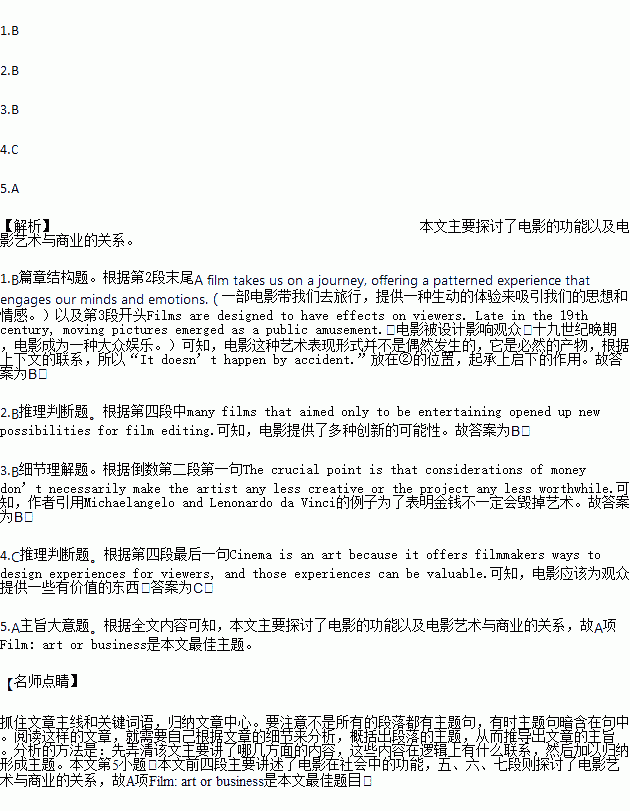题目内容
Motion pictures are so much a part of our lives that it’s hard to imagine a world without them. We enjoy them in theatres, at home, in offices, in cars and buses, and on airplanes.
① For about 100 years, people have been trying to understand why this medium has so attracted us. Films communicate information and ideas, and they show us places and ways of life we might not otherwise know. Important as the benefits are, though, something more is at stake. Films offer us ways of seeing and feeling that we find deeply satisfying. They take us through experiences. The experiences are often driven by stories, with characters we come to care about, but a film might also develop an idea or explore visual qualities or sound textures. A film takes us on a journey, offering a patterned experience that engages our minds and emotions.
② Films are designed to have effects on viewers. Late in the 19th century, moving pictures emerged as a public amusement. They succeeded because they spoke to the imaginative needs of a broad-based audience. All the traditions that emerged- telling fictional stories, recording actual events, animating objects or pictures, experimenting with pure form-aimed to give viewers experiences they couldn’t get from other media. The men and women who made films discovered that they could control aspects of cinema to give their audience richer, more engaging experiences. Learning from one another, expanding and refining the options available, filmmakers developed skills that became the basis of film as an art form.
③ The popular origins of cinema suggest that some common ways of talking won’t help us much in understanding film. Take the distinction between art and entertainment. Some people would say that blockbusters(大片) playing at the multiplex are merely “entertainment”, whereas films for a narrower public-perhaps independent films for festival fare, or specialized experimental works-are true art. Usually the art / entertainment split carries a not-so-hidden value judgment: art is high-brow, whereas entertainment is superficial. Yet things aren’t that simple. As we just indicated, many of the artistic resources of cinema were discovered by filmmakers working for the general public. During the 1910s and 1920s, for instance, many films that aimed only to be entertaining opened up new possibilities for film editing. As for the matter of value, it’s clear that popular traditions can promote art of high quality. Cinema is an art because it offers filmmakers ways to design experiences for viewers, and those experiences can be valuable.
④ Sometimes, too, people treat film art as opposed to film as a business. This split is related to the issue of entertainment, since entertainment generally is sold to a mass audience. Again, however, in most modern societies, no art floats free of economic ties. Novels good, bad, or indifferent are published because publishers expect to sell them. Painters hope that collectors and museums will acquire their work. True, some artworks are funded through taxes or private donations, but that process, too, involves the artist in a financial transaction(交易). Films are no different. Others are funded by patronage or public moneys. Even if you decide to make your own digital movie, you face the problem of paying for it-and you may hope to earn a little extra for all your time and effort.
The crucial point is that considerations of money don’t necessarily make the artist any less creative or the project any less worthwhile. Money can corrupt any line of business (consider politics), but it doesn’t have to. In Renaissance Italy, painters were commissioned by the Catholic church to illustrate events from the Bible. Michaelangelo and Lenonardo da Vinci worked for hire, but it would be hard to argue that it hurt their artistry.
Here we won’t assume that film art prevents entertainment. We won’t take the opposite position either-claiming that only Hollywood mass-market movies are worth attention. Similarly, we don’t think that film art rises above commercial demand, but we also won’t assume that money rules everything. Any art form offers a vast range of creative possibilities. Our basic assumption is that as an art, film offers experiences that viewers find worthwhile.
1.Where should the sentence “It doesn’t happen by accident.” be put in the passage?
A. ① B. ②
C. ③ D. ④
2.Which of the following statements about film is TRUE?
A. Hollywood films are usually far more appealing.
B. Film offers a wide variety of creative possibilities.
C. Films are made in the hope that consumers will pay to see them.
D. When watching films, viewers feel controlled by film designers.
3.The writer uses the examples of Michaelangelo and Lenonardo da Vinci to ______.
A. indicate that money is unlikely to corrupt artistry
B. show that money doesn’t necessarily destroy artistry
C. prove that money cannot buy everything in the field of art
D. suggest that money is an important concern even for famous artists
4.According to the writer, film should ______
A. avoid concentrating on popular traditions
B. focus on artistry rather than entertainment
C. provide the audience with something worthwhile
D. earn enough to pay for the developers’ time and effort
5.Which of the following can be the proper title for the passage?
A. Film: art or business B. Art or entertainment
C. Film offers us experiences D. Money doesn’t rule everything

